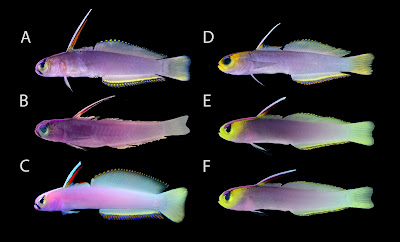Abstract
Nemateleotris lavandula, new species, is described on the basis of the holotype from Augulupelu Reef, Palau, and twelve paratypes from across the western and central Pacific Ocean, including Fiji, Guam, Japan, and the Marshall Islands. The new species was previously confused with Nemateleotris helfrichi, but molecular analysis of mitochondrial COI reveals a difference of 1% in sequence data between both species, in addition to differences in morphometric measurements, live, and preserved colouration details. Both species are allopatric and do not overlap in distribution. The new species is readily separated from all congeners based on the following combination of characters: body lavender to lilac in life; maxilla unmarked, bright yellow in life; caudal fin truncate to weakly emarginate, unmarked, pale yellowish green in life; and snout, lower jaw, preopercle, and postorbital region bright yellow in life. We comment on the relationships among species of Nemateleotris, the taxonomic status of N. exquisita, and the doubtful identity of Zagadkogobius ourlazon. A revised key to species of Nemateleotris is provided.
Key words. dartfish, mesophotic, gobioid, Ptereleotrinae, Microdesminae
 |
| head profiles of N. helfrichi (left) and N. lavandula, new species, (right) showing difference in colouration of the head and maxilla |
Nemateleotris lavandula, new species
Lavender-blushed Dartfish
Diagnosis. Nemateleotris lavandula is most similar to N. helfrichi, sharing with it the following combination of characters and live colouration details to the exclusion of all other Nemateleotris: caudal fin truncate to weakly emarginate; dorsoposterior ctenoid scales with fewer than 10 ctenii; elevated portion of first dorsal fin blue on anterior edge; median fins pale yellowish green, caudal fin without any markings, outermost edge of second dorsal and anal fin tipped with a yellow or orange spot, one in each interradial membrane space; body lavender to lilac in life; pelvic fins black-tipped; dorsal edge of iris with a black mark at 1 o’clock position, sometimes continuing onto interorbital space as a short streak. It is readily separated from N. helfrichi and all other congeners based on the following: maxilla unmarked (bright yellow in life, pale tan in preservation); and snout, lower jaw, preopercle, and postorbital region bright yellow in life.
Etymology. The species is named lavandula, after the genus of Lavandula flowering plants which includes the ornamental herb lavender, in reference to its beautiful colouration in life. To be treated as a noun in apposition.
Yi-Kai Tea and Helen K. Larson. 2023. Synopsis of the ptereleotrine Goby Genus Nemateleotris, with Description of A New Species from the western and central Pacific Ocean (Teleostei: Gobiidae). RAFFLES BULLETIN OF ZOOLOGY. 71; 248–266.



